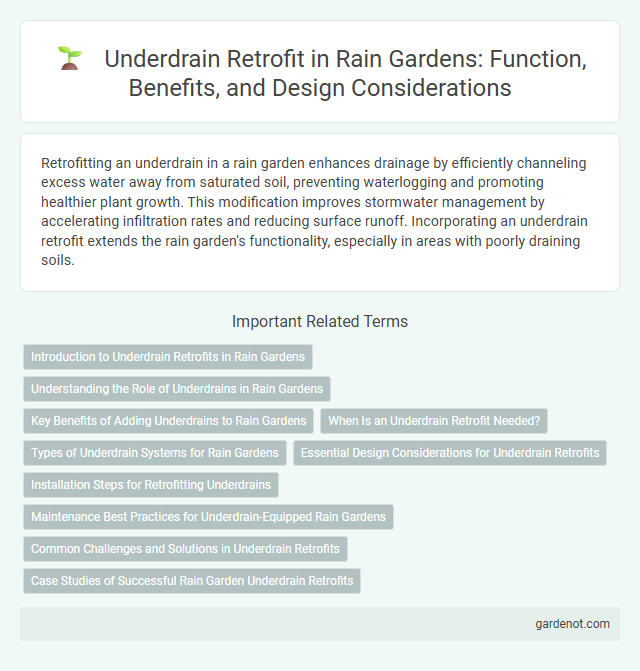Retrofitting an underdrain in a rain garden enhances drainage by efficiently channeling excess water away from saturated soil, preventing waterlogging and promoting healthier plant growth. This modification improves stormwater management by accelerating infiltration rates and reducing surface runoff. Incorporating an underdrain retrofit extends the rain garden's functionality, especially in areas with poorly draining soils.
Introduction to Underdrain Retrofits in Rain Gardens
Underdrain retrofits in rain gardens enhance drainage by installing perforated pipes beneath the soil to prevent waterlogging and improve infiltration rates. This retrofit addresses common issues such as slow percolation in compacted or clay soils, promoting healthier plant growth and reducing surface runoff. Properly designed underdrain systems optimize stormwater management and contribute to sustainable urban water practices.
Understanding the Role of Underdrains in Rain Gardens
Underdrains in rain gardens play a critical role in managing stormwater by facilitating efficient drainage and preventing waterlogging, which enhances plant health and soil aeration. Retrofitting underdrains involves installing perforated pipes beneath the soil media to accelerate infiltration and reduce surface ponding, especially in sites with low-permeability soils. This practice improves overall rain garden performance by maintaining optimal moisture levels and protecting groundwater quality through controlled outflow.
Key Benefits of Adding Underdrains to Rain Gardens
Adding underdrains to rain gardens significantly improves drainage efficiency by preventing waterlogging and promoting faster infiltration. They enhance stormwater treatment by directing excess runoff to appropriate discharge points, reducing the risk of surface flooding and soil saturation. Underdrain retrofits also support healthier plant growth by maintaining optimal moisture levels and preventing root damage caused by prolonged standing water.
When Is an Underdrain Retrofit Needed?
An underdrain retrofit is needed when a rain garden experiences poor drainage due to a high water table or compacted native soils that prevent adequate infiltration. It is also necessary if frequent standing water causes plant stress or reduces pollutant removal efficiency. Installing a perforated pipe system enhances water movement, ensuring optimal rain garden functionality and longevity.
Types of Underdrain Systems for Rain Gardens
Underdrain retrofit systems for rain gardens include gravel underdrains, perforated pipe underdrains, and geosynthetic wick drains, each designed to enhance subsurface drainage and maintain optimal soil moisture. Gravel underdrains use coarse aggregate layers to facilitate water infiltration and prevent soil saturation. Perforated pipe underdrains immediately collect excess water, while geosynthetic wick drains provide vertical drainage pathways, improving overall rain garden performance and longevity.
Essential Design Considerations for Underdrain Retrofits
Underdrain retrofit design in rain gardens must prioritize soil permeability and existing drainage conditions to ensure efficient water infiltration and minimize surface ponding. Selecting appropriate materials for perforated pipes and choosing optimal pipe placement depths are critical for maintaining hydraulic conductivity and preventing clogging. Proper integration with native vegetation and long-term maintenance plans further enhance system durability and stormwater management performance.
Installation Steps for Retrofitting Underdrains
Retrofitting underdrains in rain gardens involves excavating the existing soil to install perforated piping that facilitates subsurface water drainage. The installation steps include laying a geotextile fabric to prevent soil infiltration, placing a gravel bed for drainage support, and positioning the underdrain pipe at the appropriate slope to ensure efficient water conveyance. Finally, backfill the area with permeable soil and compact carefully to restore the rain garden surface while maintaining optimal infiltration and drainage performance.
Maintenance Best Practices for Underdrain-Equipped Rain Gardens
Regular inspection and cleaning of underdrain-equipped rain gardens prevent clogging and ensure efficient water flow. Flushing the underdrain system annually removes sediment buildup, optimizing infiltration rates and reducing surface ponding. Maintaining healthy vegetation supports soil stability and enhances filtration performance, extending the lifespan of the rain garden's drainage infrastructure.
Common Challenges and Solutions in Underdrain Retrofits
Underdrain retrofit in rain gardens often faces challenges such as clogging due to sediment build-up, inadequate drainage capacity, and soil compaction that limits water infiltration. Solutions include installing geotextile fabric filters, selecting perforated pipe materials resistant to corrosion and root intrusion, and implementing periodic maintenance schedules to preserve underdrain functionality. Proper design adjustments like increasing pipe diameter or adding additional outlet points enhance drainage efficiency and support sustained stormwater management.
Case Studies of Successful Rain Garden Underdrain Retrofits
Case studies of successful rain garden underdrain retrofits highlight improved drainage efficiency and enhanced stormwater infiltration in urban environments. Projects in Seattle and Portland demonstrated retrofitted underdrains reduced surface ponding by up to 40% while maintaining pollutant removal rates above 85%. These retrofits often involve installing perforated pipes or gravel layers beneath rain gardens to prevent waterlogging and promote sustained infiltration.
Underdrain retrofit Infographic

 gardenot.com
gardenot.com